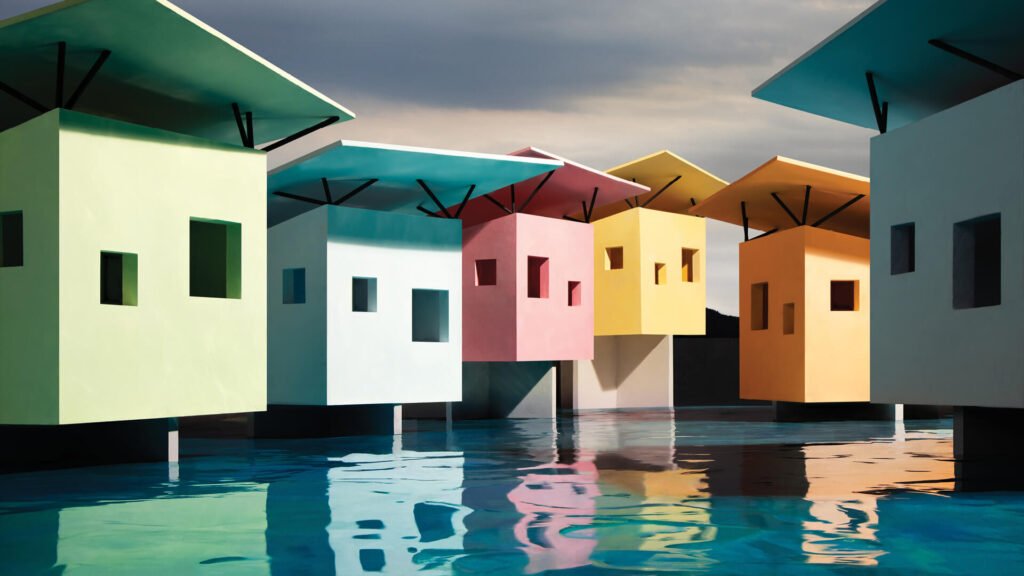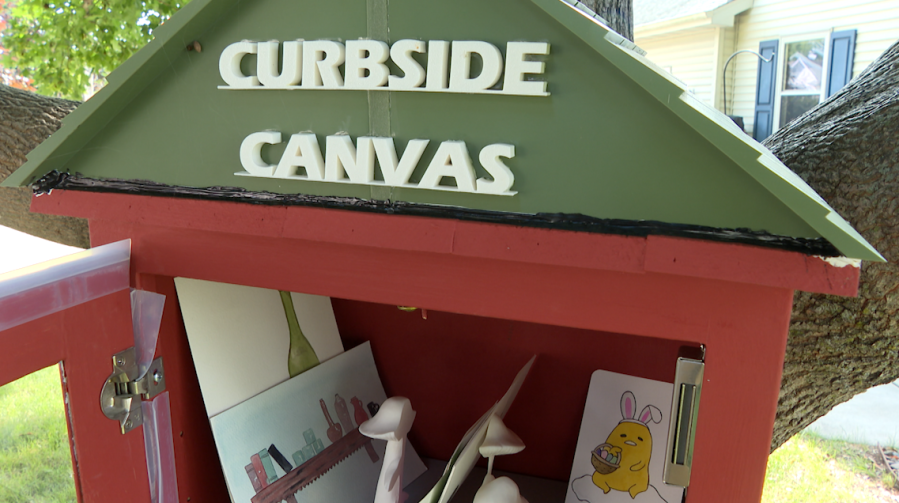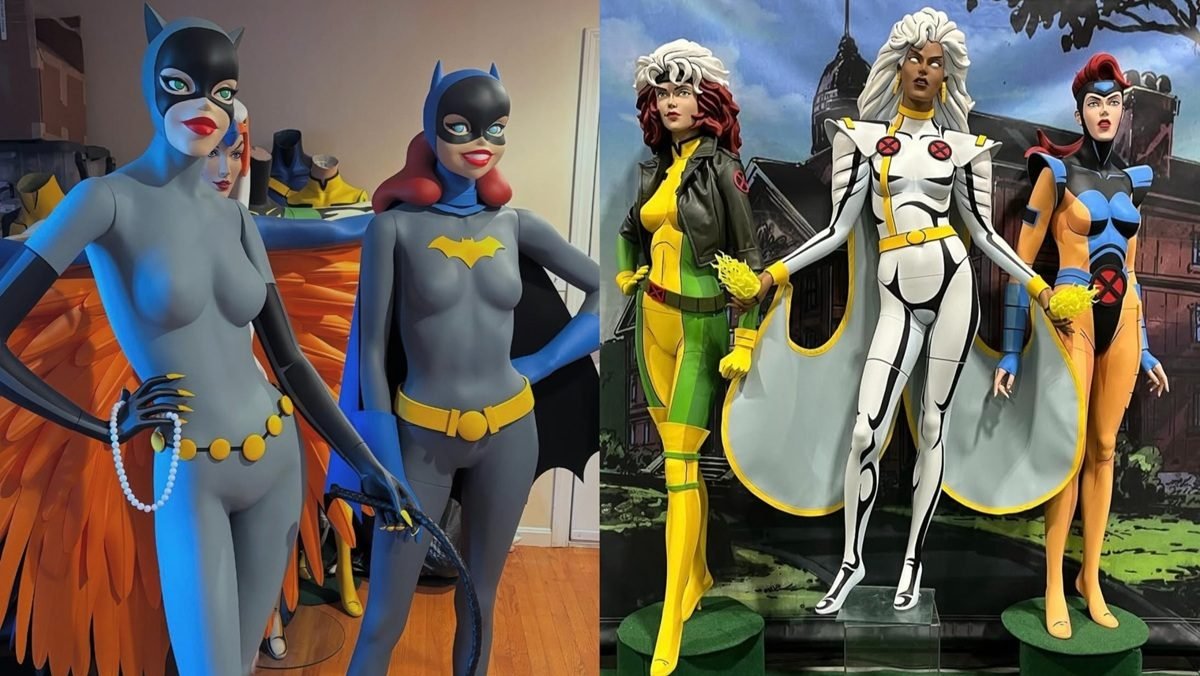At the Sean Kelly Gallery in New York, a recent show hosted on a series of images by contemporary artist James Casebere unravels the transformative power of art in creating immersive experiences while at the same time alerting the viewers of pressing global issues such as climate change. James Casebere: Seeds of Time, the ninth solo show of the American artist at the gallery transformed noted architectural designs into meticulous two-dimensional imagery in which the use of intensification of colour and a gracious addition of water “internalised the urgency and emotional context of the climate crisis while celebrating human ingenuity.” Works by distinguished architects such as Yasmeen Lari, BV Doshi, and Francis Kéré have been artistically manipulated to create vignettes that plant the seeds of change.
STIR spoke to Casebere to discover more about his interdisciplinary practice that combines architecture, sculpture and photography, as well as his craft of putting these images together.
The following are edited excerpts from the conversation.
Zohra Khan: What has been the idea behind naming the exhibition Seeds of Time?
James Casebere: In Macbeth by William Shakespeare, Banquo uses the metaphor, “If you can look into the seeds of time and say which grain will grow and which will not,” to ask the witches to predict his future. The metaphor compares predicting the future of men to looking at a group of seeds and trying to determine which will sprout and which will not. Banquo is essentially asking the witches how he can metaphorically plant the future in the present.
It is for me a question regarding how will today’s actions lead to what kind of future we will have for our planet. The decisions we make and the actions we take will add up to where we go collectively. My examples are progressive ones. Will they be planted, fertilised and grown? Which ones? It’s a challenge.
Zohra: Your artistic process encompasses a meticulous building of miniature models in which you reinterpret architectural subjects. Could you tell us more about the process of putting these little sculptures together? What drives the selection of the projects and the choice of its features that you engage with?
James: Well, I’ve been doing this kind of work since I was in art school. I’ve been building models and photographing them and it started much simpler—black and white photography, but very simple models. It got more complex as time went on.
In this case, I chose architectural projects that inspire me – Doshi’s affordable housing and organic cavern like art gallery designed in collaboration with an Indian artist; Yasmeen Lari’s co-design and co-build projects for the poor, specifically her Chulah cook stove and Francis Kere’s medical clinics, Doctors’ Housing and tech school in Kenya. I developed some forms that turned into Shou Sugi Ban sculptures that I’m showing this summer, as well at T Space in Rhinebeck, New York, at Steven Holl’s archive and the forms for my version of the cook stove and the Green House are derived from those.

Generally, I was working from original architectural drawings or photos of finished projects by the above architects, but I use artistic license and exaggeration to activate the space, energise the colour, create movement and immerse the viewer. In the case of the school, I built a 3D digital model of the building based on photos and drawings of the Lions Start Up school and laser cut the parts to build a relatively unaltered physical model of the structure which I then photographed on artificial water, in my studio and dropped in what I felt was an appropriate sky. The process is the same for all of the images except that the other ones depart in greater degrees from the original source. There is a lot of post-production re-touching in Photoshop to get the colour, texture, light and shadow to work well.
Zohra: There is a recurring thread of exaggeration (such as the intensification of colours) that weaves these images. It has also been seen in many of your previous works including the images that reinterpreted Luis Barragán architecture. Could you tell us about the idea and intent of bringing exaggeration in?
James: Well, I guess it varies. I always consider exaggeration as an intrinsic part of visual art somehow. And, I’m not trying to create a document that’s analytic, but I’m trying to move the viewer in some way and make them feel something. And so in the case of the Doshi-inspired images, the streets in particular, I’m trying to create a certain amount of visual pleasure and exaggerate that sense of joy with colour and light. I think I’m just trying to evoke certain responses that are optimistic, while at the same time flooding the space in a way that unavoidably refers to global warming. I’m still looking at this as a progressive, optimistic alternative and a way of approaching problems that we’re experiencing, looking at it as a model.
Zohra: Beyond the tool of exaggeration, have you experimented with restraint in your work? Perhaps reinterpreting some images in black and white…
James: I was tempted at one point to print the caverns in black and white. But within the context of the entire exhibition, it made sense to stick with colour.
So, yes, of course. Certainly, the prison images were about restraint and the Barragán series was more about elucidating the principles of his specific version of regional modernism. But the black-and-white work I’ve done in the last 20 years, let’s say, has exaggerated a sense of deprivation. Even in the ’90s with the prison exteriors, when I was shooting an almost all-white model, I originally shot it with colour film and made colour prints so I could engage more of the viewer’s senses – even when there was so little. At the beginning of my career, I used black and white to refer to the past, to my childhood and black and white television. Aside from those associations, black and white can also be very sensuous.
But, I suppose, more recently I have been wanting to utilise human scale and the materiality of texture, colour, movement, space and light and celebrate those, perhaps in relation to the values of Barragán, having been inspired by Mexican colour, but perhaps also because post pandemic, I want to engage the body outside the limits of an on-screen experience – encouraging a more sensual and visceral engagement with the world itself.
Zohra: The presence of water in the foreground of your architectural protagonists is another recurring aspect of your work. In Seeds of Time, water conveys an emotional context of the climate crisis. I have two questions on this:
a. How has water remained a definitive feature in your works? How would you describe your relationship with it? And has it evolved over the years?
James: It began as a metaphor for memory and its loss, the unconscious, a collective loss in relation to the holocaust and the slave trade, the unspoken voices and stories that were lost and would not be heard. But it was also an expression of abundance and change, of movement and overflow in an emotional way. I guess I have always embraced opposites like this. Water has broad symbolic potential.
Even though there were signs of climate catastrophe in my earlier work it only manifested in the Landscape with Houses series and then morphed into images of flooding via climate change etc., with Hurricane Sandy. But it is never just foreboding, it is also sometimes calm and serene and in this show it seems almost cool and soothing, it is no longer about ringing warning bells but representing the ever-present background reality of our shared everyday life.

b. The images seem to balance a sense of looming danger and the lasting survival of the inanimate. Thoughts?
James: I like the way you put that. However, for me, it was more about highlighting examples of change that might allow us to direct the course of events, to plant the seeds of change in the hope they will take us in a better direction.
There are a couple of associations I would make, I suppose, but I think the inanimate that’s surviving in these images is also manmade and it’s made to do no harm and to mediate the effects of climate change, if possible, collectively. There’s also a sense of suggestive ruin to a certain extent. Like even the Chulha cook stove, the way I’ve rendered it, suggests a kind of pre-Columbian ancient architecture in America where the civilisation is lost, the people have disappeared and the empire has collapsed. So there is a reference that there will be remnants that survive. But I’m also trying to look at options more constructively, not to just be all doom and gloom.
Zohra: What has been the most rewarding aspect for you in putting this series together? And the most challenging?
James: I think the rewarding part for me in this particular body of work was just the sense of starting over from scratch. Like working intuitively to solve problems, but kind of with a blindfold at times. And then finding the solutions in the process and just trusting my intuition. There may be a lack of logic in some cases, but I think I was just accepting the fact that I may be accepting the notion that they’re poetic gestures and I’m not trying to be didactic and descriptive entirely. It was the dreamy, developmental uncanny character of where the work took me when it took me away from my rational intent and about finding something new in the playful departure from my original referent that gave me the most pleasure. So I guess trusting my imagination was the most rewarding. And I think it was also the most challenging aspect, to give up your plan in a way and go with the flow in the midst of the process.












